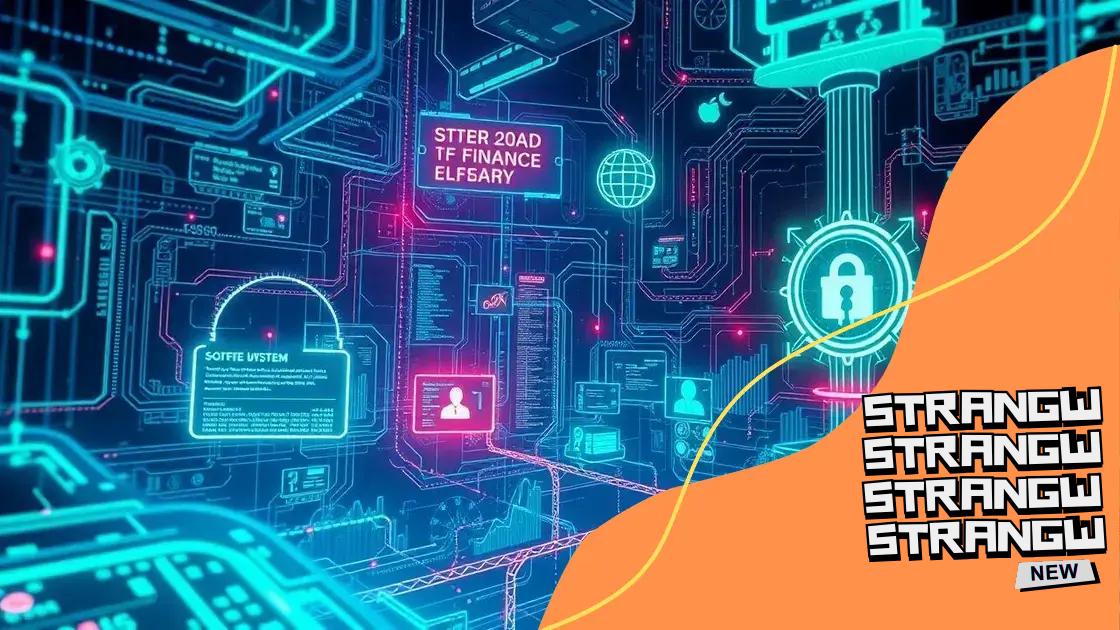Decentralized finance (DeFi) innovations transforming markets

Decentralized finance (DeFi) enables direct financial transactions through blockchain technology, eliminating intermediaries and providing users with opportunities for lending, borrowing, and trading in a secure and accessible environment.
Decentralized finance (DeFi) innovations are reshaping the financial world in ways we never imagined. From simplifying transactions to creating investment opportunities, these advancements invite us to rethink our approach to money and banking. Curious about how they might impact your financial decisions?
Understanding decentralized finance (DeFi)
Understanding decentralized finance (DeFi) is essential as it reshapes our view of traditional financial systems. Unlike conventional finance, DeFi operates on blockchain technology, offering innovative solutions that enhance accessibility and security.
The Basics of DeFi
In the simplest terms, DeFi aims to create an open financial system without intermediaries like banks. This approach empowers individuals with direct access to financial services.
Key Components of DeFi
Several crucial elements make up the DeFi ecosystem:
- Smart Contracts: These are self-executing contracts with the terms directly written into code.
- Decentralized Applications (dApps): dApps provide various services, such as trading, lending, and borrowing.
- Liquidity Pools: These pools allow users to contribute assets and earn rewards while providing funds for trading.
By utilizing these components, DeFi platforms create a decentralized environment that is transparent and efficient. This model significantly lowers the barriers to entry for many users.
Many people are turning to DeFi as a way to manage their finances. With services like yield farming and decentralized exchanges, users can earn rewards or trade assets directly and securely.
Understanding how DeFi operates is crucial for anyone interested in financial innovation. Unlike traditional finance, where trust is placed in institutions, DeFi relies on technology. This shift encourages a new mindset regarding how we engage with our finances.
Key innovations driving DeFi
Key innovations driving DeFi highlight how this emerging sector is changing the financial landscape. By leveraging technology, these innovations provide better access and security for users.
Automated Market Makers (AMMs)
AMMs allow users to trade assets without needing a traditional order book model. Instead, they use algorithms to determine pricing based on supply and demand.
- Liquidity Pools: Users can contribute assets to pools and earn fees from traders who use the platform.
- No Order Book Needed: AMMs facilitate trades directly between users, enhancing accessibility.
- Lower Fees: By eliminating middlemen, users often pay lower transaction fees.
Another significant innovation is the rise of lending protocols. These platforms enable users to lend and borrow assets without a centralized authority. They utilize smart contracts to automate processes and ensure security.
Yield Farming
Yield farming has captivated DeFi enthusiasts, allowing users to maximize their returns on crypto assets. By moving assets across various platforms, users can find the highest yields available.
This approach encourages competition among DeFi protocols, leading to better rates for users. As a result, more individuals are exploring how to optimize their investments within the DeFi ecosystem.
In addition, decentralized insurance is gaining traction. This innovation protects users against risks associated with smart contracts and hacks. By pooling funds among participants, decentralized insurance offers coverage in a more transparent and equitable way.
Challenges facing DeFi platforms

Challenges facing DeFi platforms are crucial to understanding their potential and limitations. While DeFi offers revolutionary changes, it also faces various obstacles that can hinder its growth.
Security Risks
DeFi platforms are vulnerable to hacks and exploits. As more money pours into these applications, they attract malicious actors who look for weaknesses to exploit. Security breaches can lead to significant losses for users.
- Smart Contract Vulnerabilities: Flaws in coding can be exploited, leading to unplanned outcomes.
- Rug Pulls: This scam occurs when developers abandon a project and take investors’ funds.
- Phishing Attacks: Users can be tricked into giving away sensitive information.
Another challenge is regulatory uncertainty. Governments are still figuring out how to approach DeFi. Different countries may impose regulations that affect the usability and legality of these platforms.
Scalability Issues
As more users adopt DeFi, scalability becomes a concern. Many platforms struggle to handle increased traffic, leading to slow transaction times and high fees.
On some networks, increased activity can cause congestion. This situation makes users frustrated and hesitant to engage with the platform. Developers are actively seeking solutions to improve performance.
User experience is also vital for adoption. Many DeFi platforms have complex interfaces, making navigation difficult for newcomers. A steep learning curve can discourage individuals from utilizing these services.
Real-world applications of DeFi
Real-world applications of DeFi showcase how this innovative technology brings new possibilities to finance and everyday transactions. These applications are making waves in various sectors, demonstrating the utility of decentralized finance.
Decentralized Lending and Borrowing
One of the most popular applications of DeFi is in lending and borrowing. Users can lend their assets to others and earn interest without intermediaries. On the other hand, borrowers can access funds quickly and often at lower rates.
- Flexible Terms: Users can choose loan lengths and collateral types.
- Global Access: Anyone with an internet connection can participate.
- Transparent Rates: All terms are clear, with no hidden fees.
In addition, decentralized exchanges (DEXs) are empowering users to trade without relying on a centralized authority. These platforms allow individuals to swap cryptocurrencies directly, enhancing privacy and security.
Non-Fungible Tokens (NFTs)
The rise of non-fungible tokens (NFTs) within the DeFi space is another exciting development. NFTs can represent ownership of digital art, collectibles, and even virtual real estate. Artists and creators can receive direct compensation for their work without intermediaries.
Furthermore, DeFi protocols are enabling more creative uses of NFTs. For instance, users can stake their NFTs to earn rewards. This innovation enhances the value and usability of NFTs in various ways.
Finally, crowdfunding and fundraising through DeFi are simplifying capital acquisition for startups. Entrepreneurs can raise funds directly from the community, bypassing traditional venture capital channels. This means that anyone can support projects they believe in.
The future of decentralized finance
The future of decentralized finance is bright and filled with potential. As technology advances, the applications of DeFi will likely expand, providing users with more options and opportunities.
Increased Adoption
One of the significant trends is the expected increase in adoption among mainstream users. More individuals will learn about DeFi and how it can benefit their financial activities. As platforms improve their user interfaces, engagement will rise.
- User Education: Efforts to educate users will help them understand the workings of DeFi.
- Integration with Traditional Finance: DeFi services may begin to interact more with traditional financial institutions.
- Regulatory Clarity: Clearer regulations can encourage more users to participate.
Moreover, innovations such as layer-two solutions are being developed to address scalability issues. These solutions can enhance transaction speeds and lower fees, making DeFi platforms more appealing.
Interoperability
The future will likely see greater interoperability between different DeFi protocols. This means that various platforms will work together more seamlessly, allowing users to move assets quickly and easily across platforms.
With enhanced interoperability, users can access a wider range of services without the hassle of converting assets or navigating various wallets. This improvement can make DeFi more user-friendly and efficient.
Furthermore, the concept of decentralized autonomous organizations (DAOs) will play a vital role in governance. DAOs empower users to participate in decision-making processes about the development and functionality of DeFi platforms. This shift toward community governance can lead to more democratic and responsive platforms.
Conclusion: The future of decentralized finance is promising and full of opportunities for growth and innovation. As adoption increases, users will gain access to more services that enhance financial experiences. Enhanced security, better scalability, and interoperability will make DeFi platforms easier to use and more attractive. Moreover, the involvement of DAOs in decision-making will empower users, creating a more inclusive financial landscape. By embracing these advancements, we can look forward to a more decentralized and efficient financial world.
FAQ – Frequently Asked Questions about Decentralized Finance (DeFi)
What is decentralized finance (DeFi)?
Decentralized finance (DeFi) refers to a financial system built on blockchain technology that eliminates intermediaries, allowing users to lend, borrow, and trade directly.
How does DeFi ensure security?
DeFi platforms use smart contracts to automate processes and minimize the risk of human error. However, security remains a concern due to potential vulnerabilities.
Can anyone participate in DeFi?
Yes, anyone with an internet connection can participate in DeFi. It is designed to be accessible to anyone, regardless of their financial background.
What are the risks associated with DeFi?
Risks include security vulnerabilities, regulatory uncertainties, and potential financial losses due to volatile market conditions.





